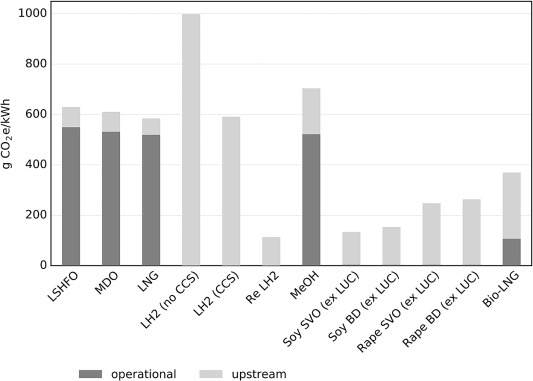As the shipping industry needs to move to renewable and alternative fuels to reduce environmental footprint, there is no widely available fuel to manage climate change and local pollutants, according to a recent study by the University of Manchester.
Highlights
- Alternative shipping fuels are needed to manage climate change and local pollutants.
- LCA is used to quantify environmental impacts of current and future fuels.
- There is no widely available fuel to manage climate change and local pollutants.
- Hydrogen and biofuels have significant impacts upstream in the fuel life-cycle.
- Minimising these impacts may reside beyond the scope of the shipping sector alone.
The research team says there is a need for alternative fuels in shipping for two main reasons; to reduce local pollutants and comply with regulation; and to mitigate against climate change and cut GHG emissions.
Alternative fuels are defined as any other fuel than conventional fossil fuels that can be used for powering ships. The alternative fuels assessed in the study were LNG, methanol, liquid hydrogen (LH2) (with and without carbon capture and storage), biodiesel, straight vegetable oil (SVO) and bio-LNG.
However, the analysis demonstrates that no widely available fuel exists currently to both reduce the environmental impact and comply with current environmental regulation. Some of the alternative fuel options analysed have the potential, but only if key barriers can be overcome.
Dr Paul Gilbert, Senior Lecturer in Climate Change Mitigation, explained:
There is, at present, no readily available fuel option to deliver significant savings on local pollutants and greenhouse gas emissions in tandem. In particular, LNG is a promising option for meeting existing regulation, but it is not a low greenhouse gas emissions fuel. As the urgent need to curtail greenhouse gas emissions is the more severe challenge, it is therefore important to ensure that any short-term measure doesn’t diminish the potential roll-out of low carbon fuels.

In particular, researchers from the University’s Tyndall Centre for Climate Change carried out a life cycle assessment of current and future fuels used by the shipping companies to quantify their environmental impacts. They measured the impacts by using six emissions types: pollutants (sulphur oxides, nitrogen oxides, and particulate matter) and greenhouse gases (carbon dioxide, methane, and nitrous oxide).
However, to become a viable alternative for the industry to adopt, the fuel must meet a range of criteria. One of the fundamental requirements is that it can deliver emissions reductions over its full life-cycle.
Dr Gilbert, from School of Mechanical, Aerospace & Civil Engineering, added:
To understand the full extent of the environmental implications it is important to consider the emissions released over the full life-cycle and not just during fuel combustion. Otherwise, there is a risk of misleading the industry and policy on the true emission penalties of any alternative fuels.
The study, published in the Journal of Cleaner Production, says effort needs to be directed at overcoming barriers to exploiting the identified low carbon potential of fuels, or finding alternatives.
As the urgent need to curtail greenhouse gas emissions is the more severe challenge, it is therefore important to ensure that any short-term measure doesn’t diminish the potential roll-out of low carbon fuels, in particular when taking into account the long life times of ships and fuel supply infrastructure. To meet the objective of reducing greenhouse gas emissions, whole life-cycle emissions need to be accounted for.






























































